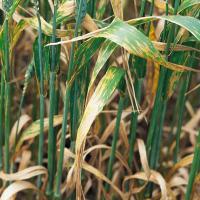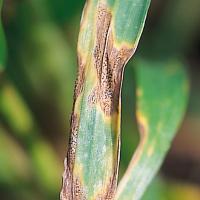Septoria tritici blotch is considered rare in WA and infections are more likely to be septoria nodorum blotch or yellow spot or a mixture of the two.
Diagnosing septoria tritici of wheat
A fungal foliar disease caused by Mycosphaerella graminicola (synonym Septoria tritici). Occurring rarely throughout the cooler areas of the Western Australian wheatbelt, which can reduce grain yield and grain quality.
What to look for
- Blotched, yellowing and dead leaves evenly distributed across paddock.
Paddock
- Irregular, elongated often interveinal leaf blotches with a narrow yellow margin.
- Rows of tiny black fruiting bodies in veins of affected leaves.
- Lower leaves affected on young plants.
- After booting, four highest leaves generally affected.
- Late infection can hasten maturity leading to shrivelled grain.
- Rarely attacks heads and glumes.
Plant
What else could it be
| Condition | Similarities | Differences |
|---|---|---|
| Diagnosing septoria nodorum of wheat | Tan leaf blotches with yellow margins | Septoria nodorum has oval to irregular lesions and can attack the head. |
| Diagnosing yellow spot of wheat | Tan leaf blotches with yellow margins | Yellow spot blotches more often start as yellow rather than tan, fruiting bodies are not present in leaf lesions, and head and glumes are less affected. |
Where did it come from?

Contaminated stubble
- Disease inoculum carried between seasons on infected stubble.
- After rain, fungal spores are ejected from sexual fruiting bodies on stubble and may be spread considerable distances on wind. Secondary generation of asexual spores occurs in black fruiting bodies on blotched leaves which are then locally dispersed within the crop by rainsplash, infecting new leaves.
- Most active in mild conditions and becomes less active towards the end of the season, except in cool areas.
- Rain splash responsible for spreading fungal spores and the disease within crops.
Management strategies

Spraying foliar
- Foliar sprays can control the disease but are only economic when conditions favour disease spread.
- Avoid early sowing susceptible varieties in medium to high risk areas, or in close proximity to infected stubbles.
- See yellow spot of wheat and septoria nodorum of wheat for foliar fungicide strategies.
Economic and financial considerations
To assist in assessing the economic risk and financial costs associated with various treatment strategies go to MyEconomicTool
There may be other economic and financial implications that need to be considered when choosing a management option. These may include:
Pre-crop- Assess the risk of septoria tritici occurring.
- Understand the potential yield losses associated with infection.
- Assess the costs and benefits of taking preventative action.
- Compare the costs, benefits and risks of each management option against doing nothing.
- Consider risk and associated costs or savings of delaying treatment.
- Consider the potential risk of re-infection and costs of further treatment.
- Ignore all previous treatment costs in assessing current management options.
- Undertake a ‘what if” scenario analysis to see what impact changing variables (e.g. grain price and seasonal conditions) have on the costs.
- Consider longer term consequences of not adequately treating septoria tritici.
View these economic considerations in more detail.
See also
Page last updated: Tuesday, 3 May 2016 - 9:53am



